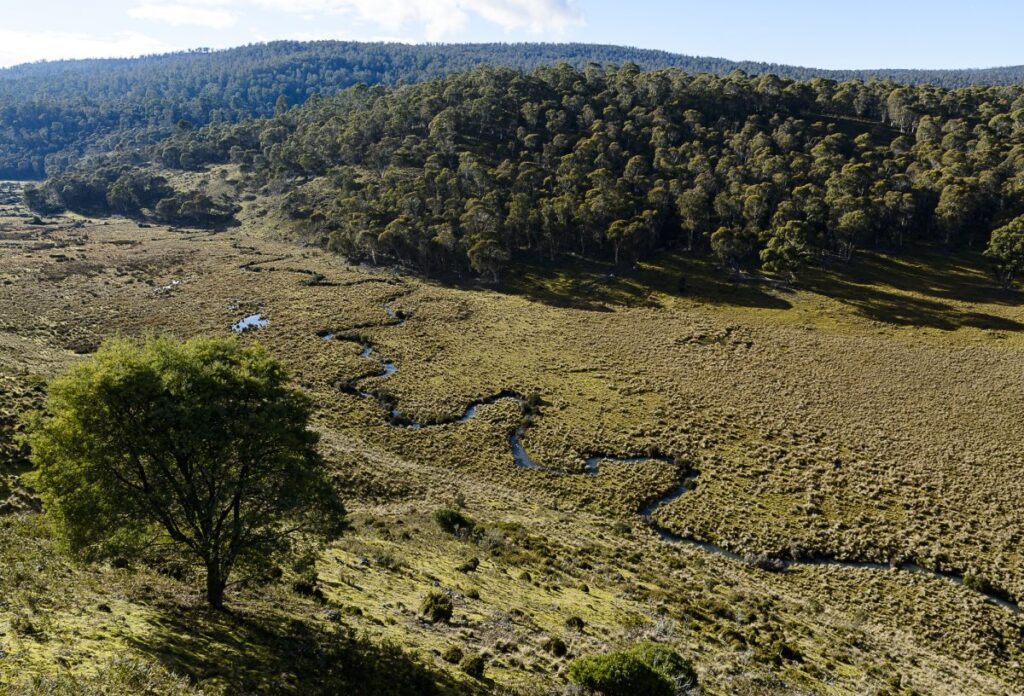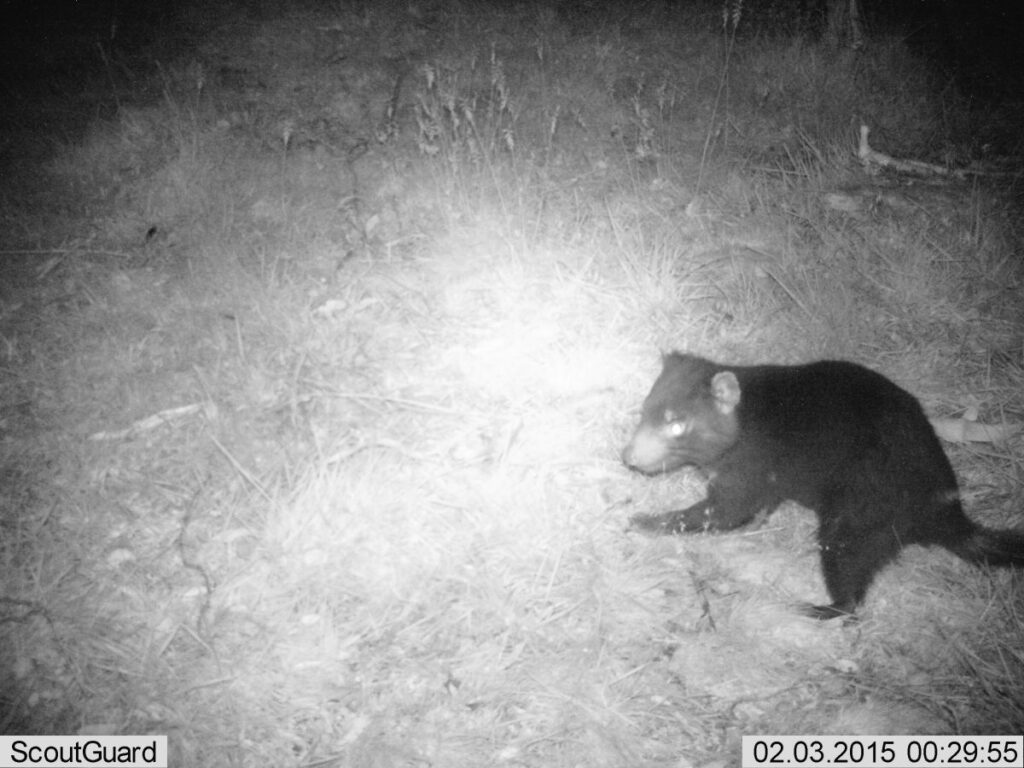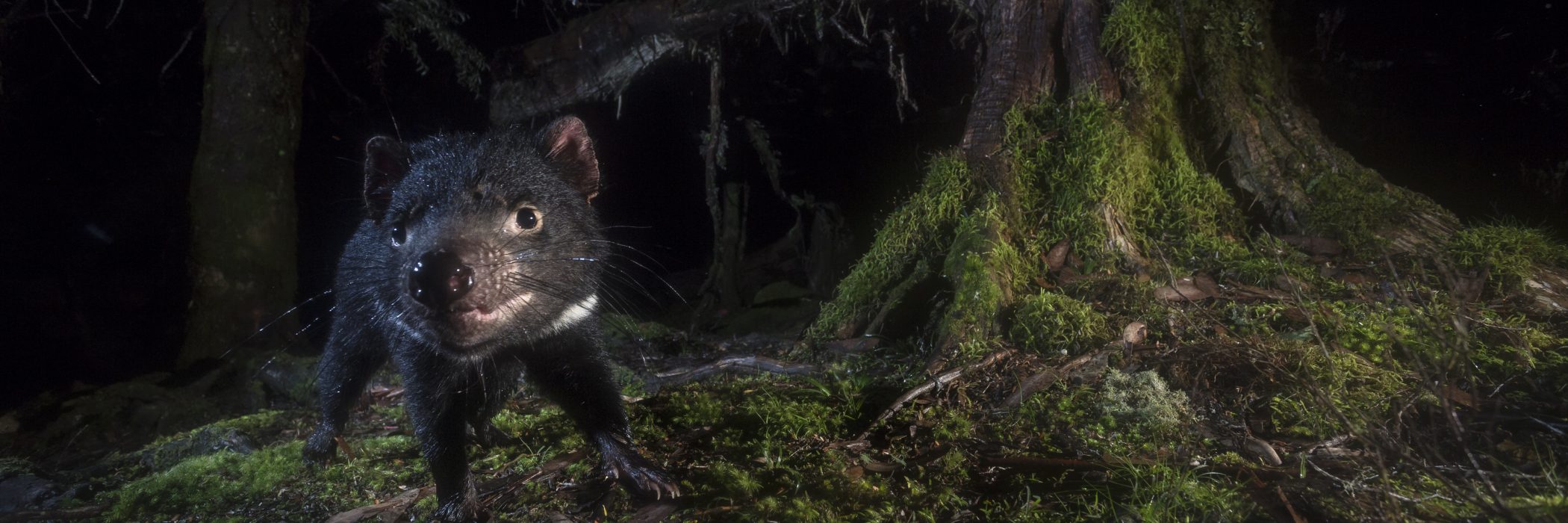Protecting the Tasmanian Devil
Providing essential habitat and security to some of Tasmania’s most endangered animals is just one of the reasons the Tasmanian Land Conservancy (TLC) believes passionately in securing long-term protected reserves.
The Tasmanian devil is one of the most intriguing of these unique animals. Once regarded as a savage predator with few redeeming features, Australia’s largest carnivore has had its image transformed courtesy of publicity surrounding the devastating Tasmanian devil facial tumour disease (DFTD). DFTD has reduced devil populations by up to 90% in some areas and highlighted the species importance to Tasmania’s ecological and cultural landscape.
As one of Tasmania’s biggest private land holders, the TLC is well placed to help ensure landscapes are protected and managed for species like the Tasmanian devil. Accordingly, in 2013 a grant from the Save the Tasmanian Devil Program (STTDP) enabled the TLC to establish a carnivorous marsupial monitoring program and aid the incredible work undertaken by the STTDP to save the Tasmanian devil from extinction. Two permanent reserves held by the TLC are now long-term main stays of the STTDP monitoring program; the Five Rivers Reserve near Bronte, in the Central Highlands along with the Silver Peppermint Reserve in the Derwent Valley region.
“Trapping on secure, protected reserve sites like the TLC’s site at Bronte reduces the likelihood that major environmental disturbances, like harvesting in forest sites for example, will influence our results,”
— Clare Lawrence

BRONTE DEVIL SURVEY
In May 2017 the STTDP conducted eight days of monitoring at the Bronte site, which encompasses the TLC’s Five Rivers Reserve. DFTD was first detected at the Bronte site in 2001, making it one of the longest-diseased site included in the annual monitoring program. The site also has one of highest prevalence of DFTD, making it one of the most significant for mapping populations trends and the evolution of disease.
The 2017 trip was the fifth consecutive year that the program has collected monitoring data from this site. DPIPWE’s Annual Devil Monitoring Coordinator Clare Lawrence said that having long term standardised data has been critical for finding true patterns in how devils at various monitoring sites are coping with DFTD.
“Trapping on secure, protected reserve sites like the TLC’s site at Bronte reduces the likelihood that major environmental disturbances, like harvesting in forest sites for example, will influence our results,” she said, adding that regular trapping at the same sites allowed for interesting observations to be made.
“This year a devil was recaptured at a site 12 months after first being captured with signs of DFTD. This is an exceptional period of time for a devil to survive with tumours and might provide valuable insight into DFTD and how individual devils respond to infection.”
“The aim of these surveys is to determine if the population is in decline, stable or in recovery. This site is an important one as we can also collect relevant samples to further understand the disease,” Clare said.
FENTONBURY DEVIL SURVEY
The Fentonbury monitoring site encompasses the TLC’s Silver Peppermint Reserve and is an area of high devil activity that covers 300 hectares.
During the 2017 survey 43 individual devils were captured across seven days, using 40 traps – five of which were on TLC land. Dr Billie Lazenby from DPIPWE runs the Fentonbury monitoring site and said there had been a small increase in the density of devils recorded at the site over the last two years.
“Whilst it is normal for populations to fluctuate, the team from DPIPWE will continue to monitor the site to see how the population progresses over the longer term,” she said.
Also significant to the survey findings was the presence of older devils within the population. Whilst 24 of the surveyed devils were one year old, 16 were two years old and a further three were three years old. Devils in the wild rarely live beyond five years and with the pressure of DFTD, even fewer have been making it into old age. The presence of older devils at the site is something to celebrate.
The results from ongoing monitoring at this site and numerous others around the state will hopefully shed some light on the mechanism for this apparent increase in density, and whether it is likely to be sustained.
Although prevalence of DFTD cannot give us a full measure of the overall health of a devil population, ongoing monitoring means that trends can be identified and will inform the direction of the STTDP.

Sites within the Five Rivers Reserve continue to be routinely monitored by the TLC alongside the monitoring conducted through the STTDP. Through a continuous working relationship with the STTDP, the TLC hopes to share what we capture on our remote sensor cameras and population data and build upon the collective knowledge of Tasmanian devils so to better inform how we can best support their survival.
The TLC continues carnivorous mammal monitoring program with the support of tireless volunteers who, each year, interpret and catalogue thousands of photos taken at various monitoring sites. The TLC wishes to acknowledge the role they play in helping to safeguard our wildlife.



